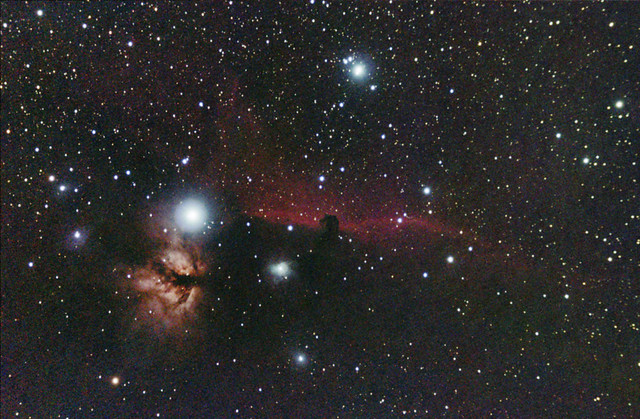Observing Log for Mike Durkin
1/23/2021 about 8:00PM-9:30PM
Locust Valley, NY
Transparency: 9/10, Seeing 2-3/5
Temperature: about 20-30 degrees
Equipment: 10x50 binoculars
Visual variabl star measurements of R Cas, V465 Cas, WZ Cas,
W Ori and η Gem.
A very cold and windy night. The hand and foot warmers helped,
more so with the feet rather than the hands.
1/19/2021 about 7:00PM-9:00PM
Locust Valley, NY
Transparency: 9/10, Seeing 4/5
Temperature: about 30-40 degrees
Equipment: Hutech modified Canon T3i
After a bit of grief last night, I thought I'd try something a little easier.
I decided to image the Hyades cluster in Taurus using the zoom lens at 70mm.
Then I wanted to try the Bower 500mm lens for photometry since the zoom lens
wasn't ideal for RW Aur. I used it to measure PDS 110 (HD 290380). There
was an alert for this star a couple of years ago and it is over now, but the
astronomers requesting this star said they would appreciate continuing
measurements. My initial reaction is that this is adequate for stars up to
about magnitude 10-11 with a 60 second exposure, although it was still
a bit faint. I defocused a bit for fear that it would saturate pixels, but
maybe I should have left it better focused and that might increase the
magnitude limit. I'm also very happy with the polar aligment I did with
the AstroTrac and using the 1x DSLR red/green dot finderscope.
1/18/2021 about 8:00PM-11:00PM
Locust Valley, NY
Transparency: 4-8/10, Seeing ??/5
Temperature: about 35-45 degrees
Equipment: Hutech modified Canon T3i and 70mm Stellarvue refractor
Tried to see if I could use the 70mm refractor with the Star Adventurer
mount and the Synguider.
For a target I selected the Horsehead and Flame nebula in Orion. I
had some trouble getting a target star in the Synguider. And a couple
of times, once I started guiding, the frame in the Canon camera had
shifted a bit and I had to move it again.
Eventually I did start taking images, but I noticed that there was a
significant amount of "wobble" even from the mirror slap. Also the
polar aignment was off a little bit so the stars did drift a little bit
as well.
Overall I don't think this combination is very good. The mount is way
to woobly with this load. Maybe a camera tripod that is more heavy duty
would be appropriate.
I am also considering that maybe the Synguider can work on the Celestron
Ultima 8 with PEC, which would free up a laptop.
1/16/2021 about 8:00PM-11:00PM
Locust Valley, NY
Transparency: 7-9/10, Seeing 4/5
Temperature: about 30-40 degrees
Equipment: Hutech modified Canon T3i
DSLR photometry of γ Cas, κ Cas, ρ Cas, ε Aur, X Per and RW Aur. This is my
first attempt at RW Aur and I tried to use the 70-300mm zoom lens with 1 minute exposures. My
initial look at the results are that this star is a bit too faint for this lens setup. Perhaps
I should have tried the 500mm Bower lens instead.
Also a visual measurement of α Ori.
1/10/2021 about 7:00PM-9:00PM
Locust Valley, NY
Transparency: 6/10, Seeing 3/5
Temperature: about 25-35 degrees
Equipment: Hutech modified Canon T3i and 70mm Stellarvue
Originally wanted to do DSLR photometry, but there was again a thin layer of clouds all over.
So instead I Just did some visual measurements of DM Cep, PQ Cep, S Cep and η Gem.
I also took a quick look at Mars and Uranus. No details visible on either and I don't think I quite
saw Uranus as a disk, and the color didn't seem obviously unusual compared to a star.
1/9-10/2021 about 11:00PM-1:00AM
Locust Valley, NY
Transparency: 6/10, Seeing 3/5
Temperature: about 30-40 degrees
Equipment: Hutech modified Canon T3i and 60(?)mm Mak
Wanted to see if the small Mak I got from ALCON was usable for astrophotography. Aiming
was very difficult as expected. Using the finderscape did help, although it would rotate
the Mak and move the scope a bit.
I started trying to get the Horsehead nebula. Even with 60 second exposures, the nebula
was never really visible in the image. Longer exposure also showed that there was a lot
of vignetting.
Focusing is also a bit tough because I can only use live preview on the very brightest
stars, about magnitude 1 or brighter.
I also tried to see if I could get a quick image of M41 near Sirius since it might
fit in the vignetting circle, but clouds were a bit of an issue.
Overall I don't think this is a good scope for astrophotography except for maybe some
small and bright star clusters.
1/2/2021 about 5:30-9:00PM, intermittent
Locust Valley, NY
Transparency: 6/10, Seeing ??/5
Temperature: about 30-40 degrees
Equipment: Hutech modified Canon T3i
DSLR photometry of P Cyg, X Per and ε Aur.
Unfortunately throughout the whole evening, there was at least a thin layer of
clouds all over, so all this might be garbage.
<-- 2020 Jan Feb Mar Apr May Jun Jul Aug Sep Oct Nov Dec 2022 -->

